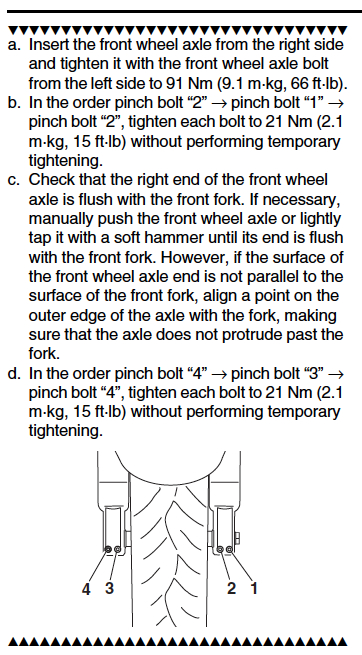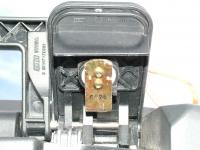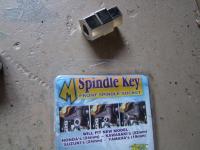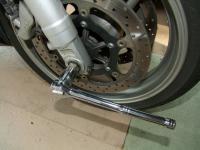jimjim
Member
Found one of my front axle pinch bolts close to falling out loose, brand new just under a 1000 miles. Can someone share the torque spec for these?


... brand new just under a 1000 miles...










Who is this HAshe guy?Apply a liberal amount of anti-seize to the threads. You may want to reduce the torque spec by roughly 2.0 foot-lbs. if you are trying to be precise with the torque. Torque specs are based on clean, dry threads.But the anti-seize will keep those bolts and the mating aluminum castings healthy for a long time to come. I'm a firm believer in anti-seize for frequently serviced steel-to-aluminum connections, and 242 Loktite for others.
Although I put up that Yamaha recommendation, I don't necessarily follow it myself...
Well, having removed/reinstalled the 2013 Gen III front wheel for the first time.. I found I could not follow the above sequence...
Before I could reach 66ft-lbs, the axle would start to rotate in place. Had to snug down #3 and #4 to prevent axle slippage before the torque wrench clicked over at the 88 ft-lb setting.
The I followed the prescribed FredW method of just tightening the **** down properly. I did, however, put a dash of HAshe-approved anti-sieze on the fork bolts threads.



...if you really do want to use the anti-seize material ... reduce the amount of tightening torque by about 40 percent. If you dont, you run the risk of cracking the ceramic and/or stretching or even breaking the threads on the plug shell....
So we are both "doing it right." I know for a fact that my axle is not flush when it is in the right position. It stands about a millimeter proud of the lower leg casting when it's in the correct (happy place) position. It's great that you have found the magic elixir for your head shake, but that said, I don't really see how the lateral axle to fork leg relationship would either induce nor inhibit head shake.INSTALLING THE FRONT WHEEL
The following procedure applies to (sic) both brake discs. (??)
1. Lubricate:
• wheel axle
• oil seal lips
2. Tighten:
• wheel axle 1
• wheel axle pinch bolt 2
CAUTION:
Before tightening the wheel axle nut, push down hard on the handlebars several times
and check if the front fork rebounds smoothly.
Enter your email address to join: